🇺🇸 US Strikes on Iranian Nuclear Sites: High Alert & Global Fallout
In an unprecedented move, Operation Midnight Hammer commenced overnight on June 21–22, 2025, when U.S. forces launched precision airstrikes on Iran’s nuclear facilities at Fordo, Natanz, and Isfahan Stealth B-2 bombers dropped Massive Ordinate Penetrators (~30,000 lbs), and Tomahawk cruise missiles from submarines hit deeply buried sites. President Trump described it as a “spectacular military success” that “obliterated” Iran’s enrichment capabilities U.S. officials claim “extremely severe damage,” though Iran insists the impact was superficial, noting no radiation leaks and that sensitive materials had been pre-moved
Immediate Retaliation & Regional Reaction
Iran quickly retaliated on June 23 with missile strikes against the Al Udeid Air Base in Qatar, launching 6 missiles—one breached defenses—with no casualties . Iran’s Foreign Minister Abbas Araghchi rejected the strikes as a violation of international law and threatened “everlasting consequences,” reserving all options
Meanwhile, allied and regional concerns mounted. Gulf states (Qatar, UAE, Oman) along with Saudi Arabia expressed deep alarm and urged diplomatic de-escalation
. Global leaders—from UN’s António Guterres to the EU’s Kaja Kallas—warned of dangerous escalation and called for a return to negotiations
US Domestic Alert Levels Surge
On the U.S. homefront, the Department of Homeland Security, FBI, and the State Department issued “Worldwide Caution” and National Terrorism Advisories, warning of heightened risk from cyberattacks, espionage, domestic extremist violence, and possible terrorism or protests. Governors in states with major military installations (e.g., Colorado) convened briefings with DHS—Colorado officials cited threats to Space Force bases and urged public vigilance, though no specific local threats were identified. FBI also held calls with state leaders on security preparedness
Impact on Diplomacy & Markets
Financial markets saw immediate turbulence: oil prices spiked on strike fears but eased after Iran’s restrained response and a tentative ceasefire between Israel and Iran. WTI crude fell ~3.2% to $66.30, with Brent at $69.08
Diplomatically, the strikes—conducted without Congressional approval—sparked domestic debate. Some Republicans, including Rep. Lindsey Graham, praised the move, while Democrats such as Reps. Jeffries and Schumer criticized it as unconstitutional and potentially dragging the U.S. into another conflict .
Wider Strategic Implications
-
Non-Proliferation Threat: The IAEA issued a stark warning about undermining global nuclear safeguards and called for immediate on-site inspections to assess damage and radiation risk
-
Iran’s Next Moves: Analysts caution Iran could escalate by disrupting the Strait of Hormuz, targeting U.S. forces in the region, and using cyber proxies or terrorism via aligned groups.
-
Global Stability: With heightened military activity, fears loom of a broader Iran–Israel conflict dragging in U.S. forces amidst mixed global reactions and calls for restraint
Summary: The U.S. strikes mark a significant escalation in Middle East tensions. While the initial military objective to degrade Iran’s nuclear infrastructure seems achieved, the aftermath includes increased risk of retaliation—both kinetic and cyber—heightened global and domestic security alerts, volatile markets, and serious diplomacy implications. The success of de-escalation hinges on whether Iran restrains further action and whether international diplomacy can re-engage swiftly.
